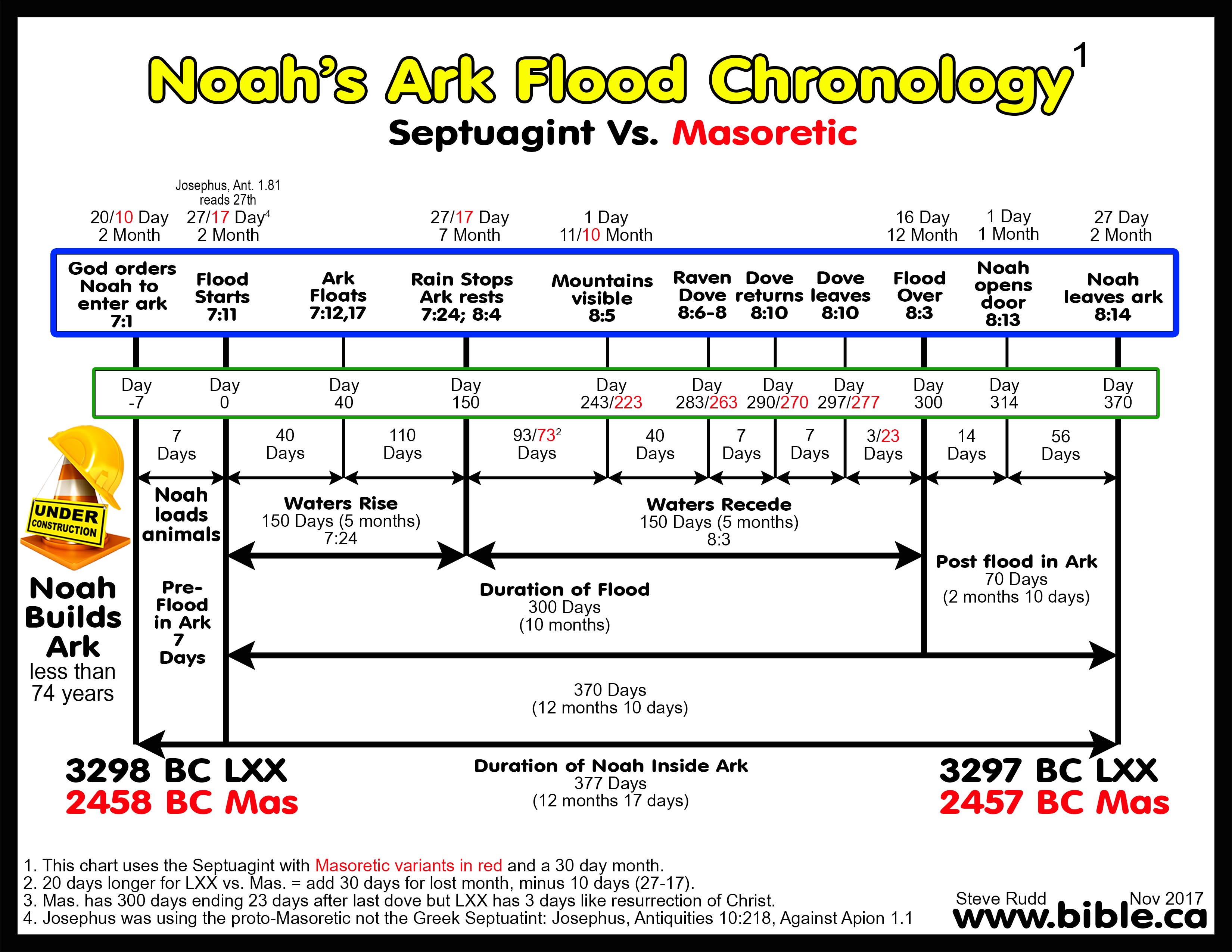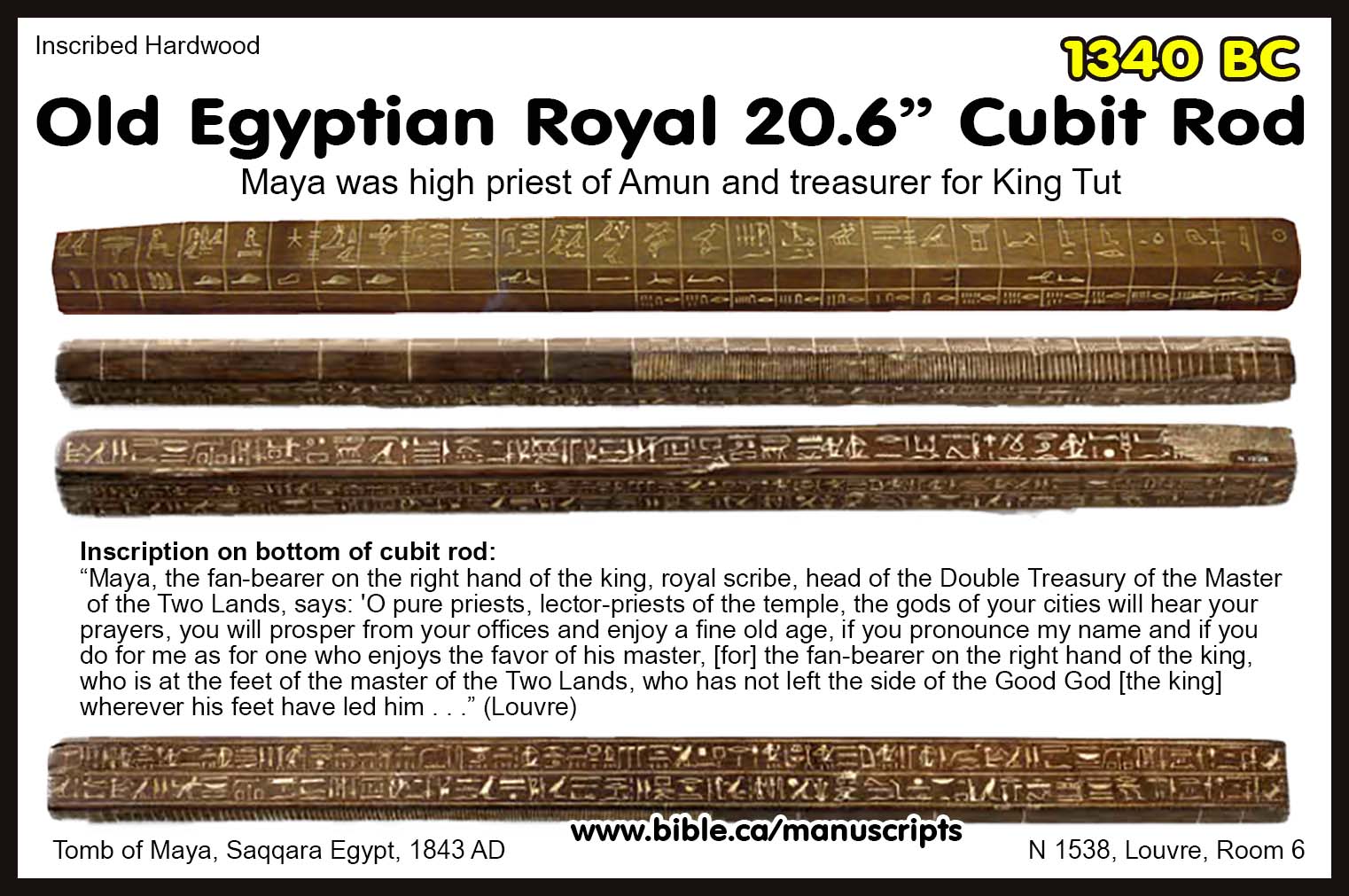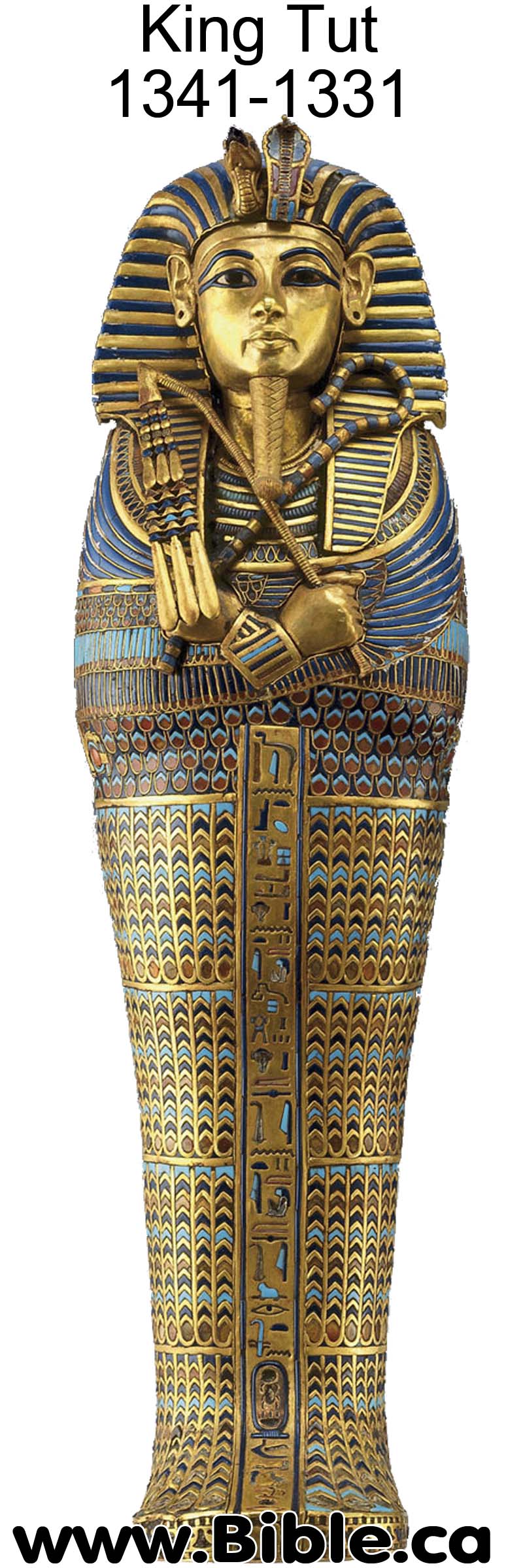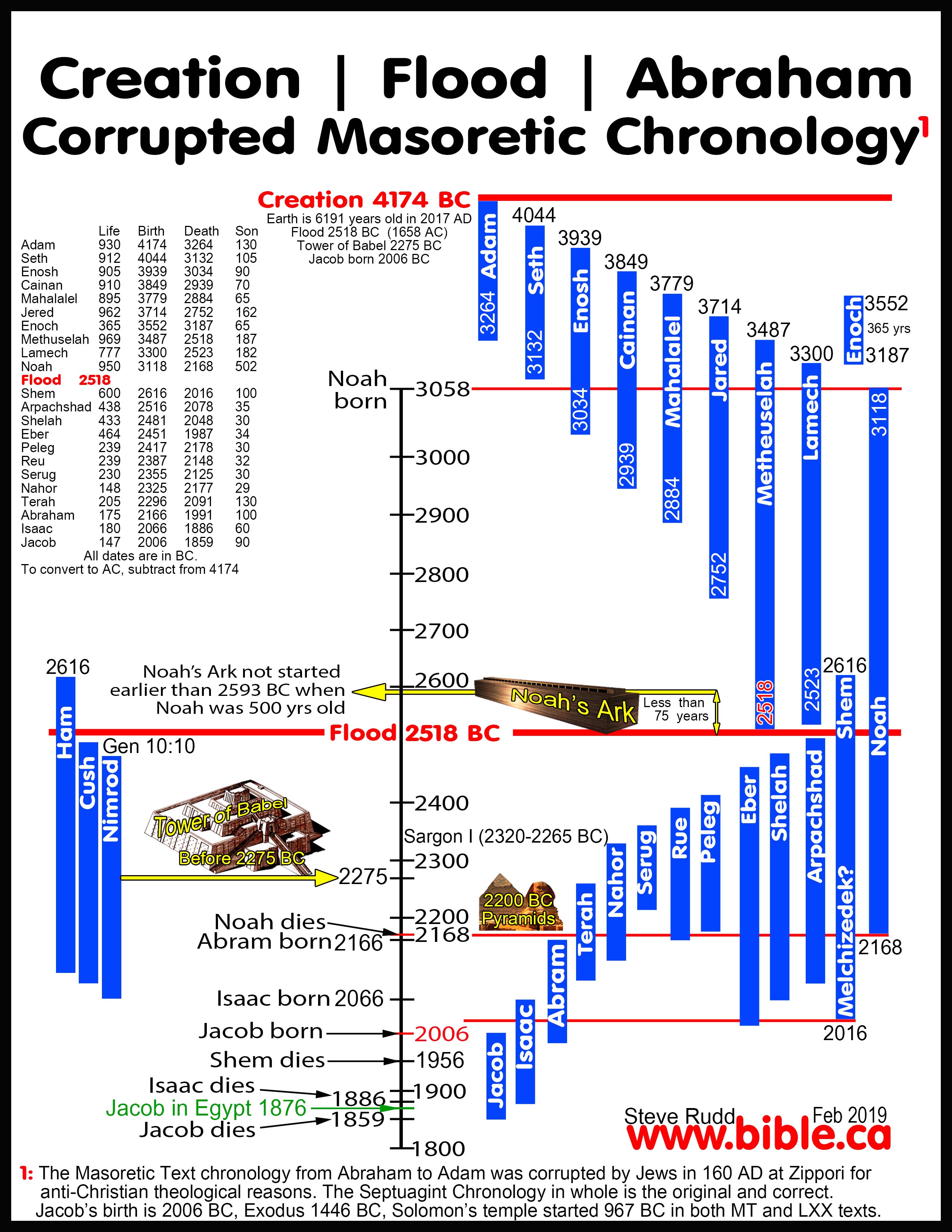|
The Search for Noah's Ark with Steven Rudd |
How long did it take to Build Noah's Ark? Less than 75 years!
How long was the flood? 300 days!
How long was Noah in the Ark? 377 Days!
The Bible is God's key that unlocks world history.
Introduction
1. Most Christians and preachers wrongly believe that Noah took 120 years to build the ark based upon a flawed and sloppy reading of Genesis 6:3. (“Then the Lord said, “My Spirit shall not strive with man forever, because he also is flesh; nevertheless his days shall be one hundred and twenty years.”)
2. A simple study of the Bible text shows that the time from when God told Noah to build the ark, till the rain fell was no longer than about 75 years.
3. The ark was as large as a modern ocean tanker:
a. When we imagine the Ark, we think of a small 30 foot Tug boat shaped vessel with a giraffe sticking his head through the roof, when in fact, Noah’s Ark was 515 feet long!
b. There was so much room on the ark that every species of animal and insect could fit on the ark and Noah had the upper deck for himself. This deck was likely used for food: Genesis 6:21
4. The construction of Noah's ark should not surprise us since the pre-flood world was sophisticated in that they had musical instruments and knew how to smelter iron.
A. Noah's Ark and Moses' Tabernacle cubit: (523mm, 20.6 inch)
1. Man's body becomes the measuring stick of the universe:
a. A cubit is the measurement from the elbow to the tip of the longest finger of the hand.
b. The common English Imperial "INCH" derives from Old English ynche, ynch, unce, or inch and was measured as the width of the main thumb-joint.
c. We also still use a "foot" as 12 inches or 12 thumb joint widths.
d. We still measure horses with "hands"
2. Which cubit did Noah Use? The old Egyptian/Babylonia cubit of course: 20.5 cubits.
a. The ‘old Egyptian/Babylon’ cubit of 20.6 inches was used in the Book of Genesis, particularly with regards to the size of the Ark. This was, according to various sources, the length of the cubit in the earliest times in Egypt, and also in Babylonia.
b. Most modern Bible translations of the Book of Genesis wrongly render the size of the ark based upon an 18-inch cubit. We know from archeology that the 18 inch cubit did not come into use until the time of Hezekiah around 700 BC because the Siloam tunnel at 1200 cubits long, gives a cubit of 17.5 inches.
c. "When preparing for my talk at the Near East Archaeological Society meeting, I reviewed a lot of the publications of Manfred Bietak and others regarding the excavations at Tell el-Daba/Avaris. Everywhere that Bietak mentions measurements, he uses the old Egyptian cubit of 20.6 inches. In one place he says explicitly that construction at Tell el-Daba followed this measurement. As an example, the two palaces at Ezbit Helmi were separated by an artificial lake, and the distance between the two palace walls was exactly 150 cubits, using the 20.6-inch cubit. These were, just about undoubtedly, the palaces where Moses was raised. Certainly they were the palaces in which Moses and Aaron found Pharaoh when warning him about the consequences of not letting the Israelites depart. So this would have been the cubit that Moses was familiar with. If he meant a different size (I don’t know when the 18-inch cubit came in), he would have said something like “according to the new-fangled shorter cubit”, but he nowhere did so. See Ezek. 40:5. Here Ezekiel had to explain that the angel was not using the 18-inch cubit that had become standard by this time, but was using the older cubit." (Rodger Young, private email, 2015 AD)
d. "The earliest attested standard measure is from the Old Kingdom pyramids of Egypt. It was the royal cubit (mahe). The royal cubit was 523 to 525 mm (20.6 to 20.64 inches) in length: and was subdivided into 7 palms of 4 digits each, for a 28-part measure in total. The royal cubit is known from Old Kingdom architecture dating from at least as early as the construction of the Step Pyramid of Djoser around 2,700 BCE" (The Cubit: A History and Measurement Commentary, Mark H. Stone, Journal of Anthropology, Volume 2014 AD)
- "For the cubit I had deduced from a quantity of material, good, bad, and indifferent, 20.64 ±.02 as the best result that I could get; about a dozen of the actual cubit rods that are known yield 20.65 ±01; and now from the earliest monuments we find that the cubit first used is 20.62, and the mean value from the seven buildings named is 20.63 b .02-. … On the whole we may take 20.62 ±.01 as the original value and reckon that it slightly increased on an average by repeated copyings in course of time." (Inductive Metrology, W. M. F. Petrie, Saunders, p50, 1877 AD)
- "The measurements which have been detailed in the foregoing pages supply materials for an accurate determination of the Egyptian cubit. From such a mass of exact measures, not only may the earliest value of the cubit be ascertained, but also the extent of its variations as employed by different architects. … For the value of the usual cubit, undoubtedly the most important source is the King's Chamber in the Great Pyramid; that is the most accurately wrought, the best preserved, and the most exactly measured, of all the data that are known." (The Pyramids and Temples of Gizeh, Field and Tuer, W. M. F. Petrie, chapter XX, 1883 AD)
|
Great Pyramid at Gizeh, Khufu |
20.620 |
|
Second Khafra |
20.64 |
|
Granite temple |
20.68 |
|
Third Pyramid Menkaura |
20.71 |
|
Peribolus walls |
20.69 |
|
Great Pyramid of Dahshur (?) |
20.58 |
|
Pyramid at Sakkara Pepi |
20.51 |
|
Fourth to sixth dynasty, mean of all |
20.63 |
|
(The Pyramids and Temples of Gizeh, Field and Tuer, W. M. F. Petrie, chapter XX, table, 1883 AD) |
|
3. Moses' cubit in use during the 18th dynasty pharaohs back to the time the Hyksos and Abraham as seen in the excavation reports at Tell el-Dab’a (ancient Goshen, Rameses and Avaris located in the eastern Nile delta at 30° 47’ N, 31° 50’ E.) The out of context quotations from "The Palatial Precinct at the Nile Branch (Area H)" by Manfred Bietak show that the 523 MM cubit (20.6 inches) was used everywhere in the construction of the palaces during the time of Thutmoses III (1446 BC, pharaoh of the exodus) down to the time of Rameses II (1250 BC). This proves Moses used 20.6 inch cubit in 1446 BC when he wrote Genesis and gave the measurements for the Tabernacle at Sinai located on modern north Saudi Arabia.
a. "This precinct of the late Hyksos Period (ph. D/2) thus far excavated consists of the following elements: Remains of a substantial fortification wall (A) along the banks of the Pelusiac branch of the Nile. It was constructed of mud-brick, 6.20 m (12 cubits) wide, and had buttresses set at regular intervals of 35 cubits. The long and straight continuation of this wall several hundred metres to the north-east was revealed by a geophysical survey in 1999." (Palatial Precinct at the Nile Branch Area H, Manfred Bietak)
b. "A monumental building on a low-level platform in area H/III (C). It is a kind of casemate construction filled with debris, which was originally at least 31.5 x 27.1 m (c. 60 x 52 cubits), but there is no absolute certainty about its eastern edge'" (Palatial Precinct at the Nile Branch Area H, Manfred Bietak)
c. "At the northern section of our excavations, the platform C of the late Hyksos Period had been taken down during the early 18th Dynasty and a storage compound set up on top of it. It consisted of at least 30 round grain silos and other silos were found beside the Palace in the south and at other places. Each silo was about 5.25 m (10 cubits) in diameter. The silos were renewed up to four times which would speak in favour of a long time span." (Palatial Precinct at the Nile Branch Area H, Manfred Bietak)
d. "The Palace District of the Tuthmoside Period, Ph. C3-2 (Str. d-c): The early 18th Dynasty palace district apparently covers a part of the same ground as the palace precinct of the late Hyksos Period but has a different orientation. It has been excavated and explored on a large scale by a geophysical survey (Fig. 1). The most prominent elements are a smaller (F) and a bigger palatial structure (G). They were set up parallel to each other and enclose a huge space in between with a breadth of 150 cubits (78.75 m). This space housed a large rectangular artificial lake." (Palatial Precinct at the Nile Branch Area H, Manfred Bietak)
e. "The three major elements of the palace district will be described in greater detail: From palace F in area H/I (Fig. 7A/7B) only a platform substructure has been preserved. Its dimensions are 135 x 90 cubits (c. 70.5 x 47 m = ratio 1.5 : 1). The huge mud-brick walls show an inner division in casemate fashion. All they represent is the foundation of a monumental elevated building. The wall compartments were filled with soil and brick material including sherds from the late Hyksos Period. The building cuts into the extended late Hyksos Period fortification wall A and rests there on a sand bed on top of it (H/I-n/25, West section). It was accessible by a ramp c. 6.40 m (12 cubits) wide, which was attached at the north-eastern (locally northern) flank of the platform. This ramp not only cuts into the remains of the Hyksos fortification wall. It must have been constructed within a long breach of this Hyksos wall (A) as, according to the geophysical survey, the eastern enclosure wall of the 18th Dynasty crosses the Hyksos wall. Blocks of a granite doorway of King Amenemhet I, found more than 100 years ago by E. Naville, are likely to have been used afterwards as an entrance gate at the start or at the upper landing of the ramp (Fig. 8A/8B)." (Palatial Precinct at the Nile Branch Area H, Manfred Bietak)
f. "Following the parallel of the "Southern Palace" at Deir el-Ballas (Fig. 9)of 200 x 90 cubits, which still stands about 7 m high, our platform can be identified as an elevated small palace on top of a podium." (Palatial Precinct at the Nile Branch Area H, Manfred Bietak)
g. "The far bigger palace G in area H/II-III and H/VI measures 320 x 150 cubits (168 x 78.75 m)" (Palatial Precinct at the Nile Branch Area H, Manfred Bietak)
h. "A ramp leads up to the palace proper, passing a bathroom at its base. With a gradient of 1:5 the length of the ramp of 70 cubits the height of the platform could be calculated to 7,35m (14 cubits)." (Palatial Precinct at the Nile Branch Area H, Manfred Bietak)
i. "There follows a bipartition of the building into a square hall (c. 55 x 55 cubits) with four rows of columns in the south-eastern part and a room configuration of equal size in the north-western half." (Palatial Precinct at the Nile Branch Area H, Manfred Bietak)
j. "The plan of the palace district of the 18th Dynasty shows clearly that the smaller palatial structure (F) and the big palace (G) were conceived at the same time within one and the same system. Both not only face the same way (see above), but have been built at an exact distance of 150 cubits from each other and enclose a common courtyard." (Palatial Precinct at the Nile Branch Area H, Manfred Bietak)
4. King Tut's 20.6 inch cubit stick found in Maya's tomb: 1340 BC
a. A 523 mm (20.6 inch) wooden cubit measuring rod was found in the tomb of Maya in Saqqara and dates to 1340 BC. Maya's name is actually on the cubit rod and he was the high priest of Amun and was an administrative overseer and treasurer for Pharaoh Tutankhamun (King Tut) and Horemheb. The impressive tomb was first excavated in 1843. The cubit rod, pictured below came from Maya's tomb and proves that right down to the time of Moses and Joshua the 20.6 inch cubit was in standard use. This particular cubit rod features 28 divisions/digits with lines at every fourth digit representing a palm.
b. "The beveled surface offers precious information: on the left are marked the digit (here 1.86 cm) and the palm (7.47 cm), while on the right the graduations show the royal cubit of 7 palms (52.3 cm) and the common cubit of 6. The other graduations correspond to units less frequently employed. On the vertical face beneath the bevel, on the right, are fifteen digits marked with their subdivisions, ranging from halves to sixteenths, the appropriate fractions being inscribed above each. On the upper surface, each of the twenty-eight digits is coupled with the name of a god, beginning on the right with Ra. The dedication on the bottom surface is a hieroglyphic inscription in which Maya calls upon the priests of an unidentified temple to pronounce the formula for the distribution of offerings from the god’s table: “Maya, the fan-bearer on the right hand of the king, royal scribe, head of the Double Treasury of the Master of the Two Lands, says: 'O pure priests, lector-priests of the temple, the gods of your cities will hear your prayers, you will prosper from your offices and enjoy a fine old age, if you pronounce my name and if you do for me as for one who enjoys the favor of his master, [for] the fan-bearer on the right hand of the king, who is at the feet of the master of the Two Lands, who has not left the side of the Good God [the king] wherever his feet have led him . . .'” Very close to Tutankhamun, he left his name on a number of objects in the latter’s tomb. His own tomb, visited by Richard Lepsius in 1843, was forgotten then rediscovered by an Anglo-Dutch archaeological team in 1986. In the Rijksmuseum van Oudheden (National Museum of Antiquities) in Leiden there is a superb life-size statue of Maya accompanied by his wife Merit. " (Maya's Cubit Rod, Louvre Museum text)
5. The
tabernacle
of Moses at Sinai and Shiloh was also constructed using a 20.6 inch cubit.
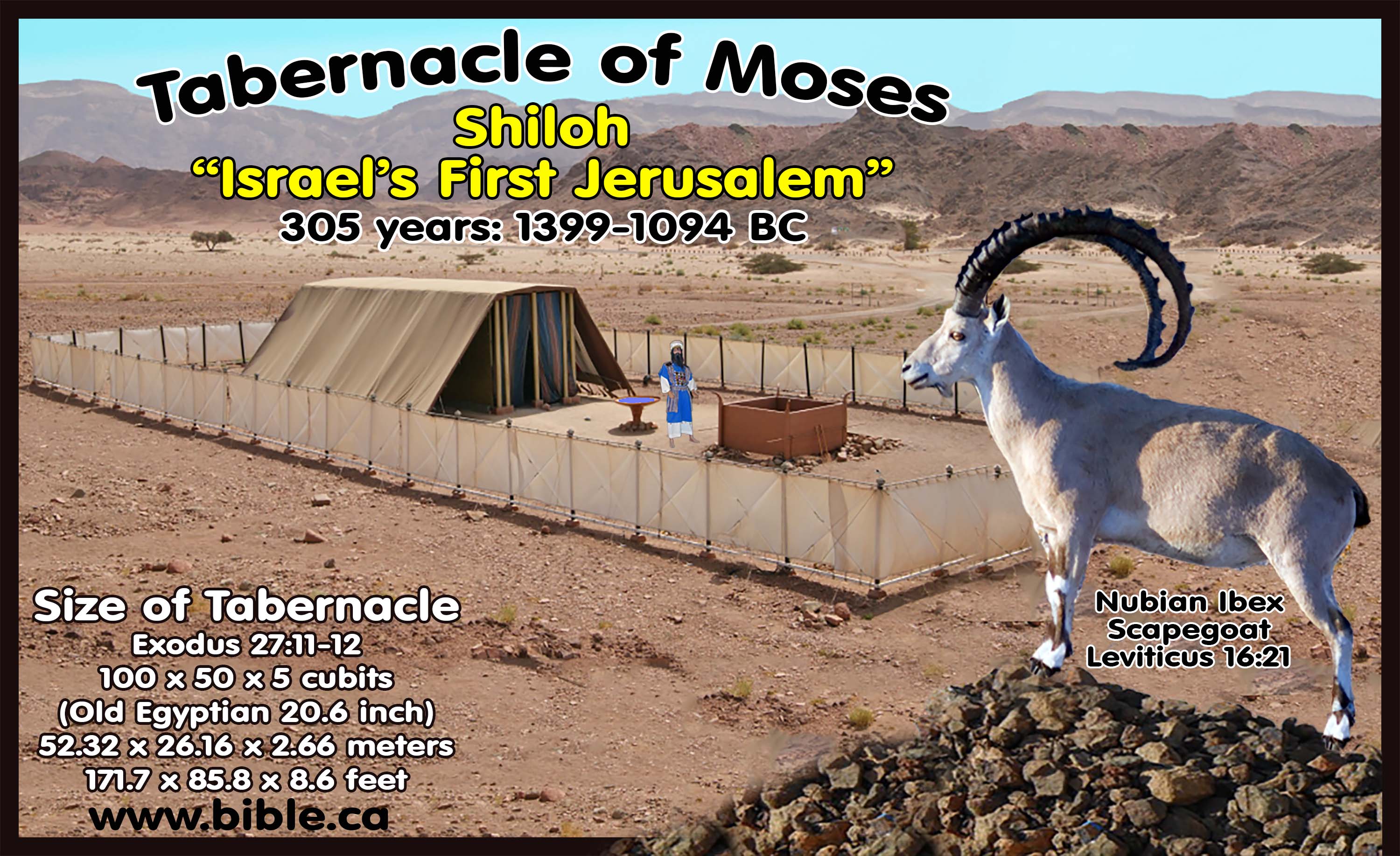
B. Size and dimensions of Noah's Ark: 515 x 85.8 x 51.5 feet (using the correct 20.6 inch cubit)
1. The size of the ark is actually given in cubits in the Bible: 300 x 50 x 30 cubits.
a. Using an 18 inch cubit, this translates to 450 x 75 x 45 feet
b. Using a 20.5 inch cubit, this translates to 515 x 85.5 x 51.5 feet
2. The size of Noah's ark using the correct 20.5 "old Egyptian/Babylonia" cubit:
|
|
Bible |
Feet |
Meters |
|
Length (Gen 6:15) |
300 |
515 |
157 |
|
Width |
50 |
85.8 |
26 |
|
Height |
30 |
51.5 |
15.6 |
|
Draft (Gen 7:20) |
15 |
25.7 |
7.8 |
C. Noah took less than 75 years, not 120 years to build the ark.
1. Noah took less than 80 years, not 120 years, to build the ark. We can prove this because the text says that Noah conceived his three sons when he was 500, and was six hundred years old when he entered the ark. Now the clincher is that when the command Noah to build the ark, God included his living sons AND their wives!
a. “Make for yourself an ark of gopher wood … “But I will establish My covenant with you; and you shall enter the ark-you and your sons and your wife, and your sons’ wives with you.” (Genesis 6:14,18)
b. “Noah was five hundred years old, and Noah became the father of Shem, Ham, and Japheth.” (Genesis 5:32)
2. Chronologically, the mention of Noah becoming the father of three sons precedes the narrative of the corruption that filled the earth and therefore the flood.
a. “Noah became the father of three sons: Shem, Ham, and Japheth. Now the earth was corrupt in the sight of God, and the earth was filled with violence.” (Genesis 6:10–11)
3. The passage that is commonly used to perpetuate the myth that it took 120 years to build the ark is Gen 6:3.
a. “Then the Lord said, “My Spirit shall not strive with man forever, because he also is flesh; nevertheless his days shall be one hundred and twenty years.”” (Genesis 6:3)
b. However, Gen 6:3 most naturally is interpreted as a limiting of the life span of mankind, not the “period of grace” that Noah preached to the doomed world as many have traditionally assumed. The passage is controversial and several phrases in the Hebrew are dubious as to their exact meaning. Given the above information, much of the controversy surrounding the meaning of Gen 6:3 is removed in favour of the natural, contextual interpretation that before the flood, men lived to 1000 years and after there would be a gradual reduction to a cap of 120 years we see today. Instead of seeing this decree of reduction of lifespan to be instant and contradicted by Patriarchs who lived longer than 120 years, it is best to see the reduction in life span as a consequence of conditions after the flood. Today and since the time of David, the 120 year cap on age is rather firm.
4. So if Noah’s three sons and their wives were alive when God commanded Noah to build the ark, the practical length of time it took Noah to build the ark was 502 years old when Shem was conceived, and given the probability he was the firstborn (unknown), and his two brothers were born, they all grew up to age 20, married etc, would calculate to the following:
a. Shem born: 502 years old
b. Two brothers born: 4 years
c. Youngest grows up to age 20 to marry: 20 years
d. Age of Noah the day his youngest son got married at age 20: 526 years old
e. Noah was 600 when he entered the ark.
f. 600-526= 74 years maximum time to build the ark and that doesn’t account for the time it took for the honeymoon of the youngest!
5. The concept that Noah preached at all to the doomed world is correctly based upon: “and did not spare the ancient world, but preserved Noah, a preacher of righteousness, with seven others, when He brought a flood upon the world of the ungodly;” (2 Peter 2:5)
6. We really don’t know for sure how long it took Noah to build the Ark. Anywhere from 10 – 74 years is possible.
D. Timing and Chronology of Noah’s flood.
1. The flood begins in 2458 BC and the total time Noah spent in the ark was 12 months, 17 days (377 Days)
a. Noah is commanded to enter the ark because the rain will start in 7 days. Most see Noah sitting in the Ark on a chair waiting the seven days, when in fact this was the cue to load the animals. Noah was busy fitting animals into the “nests” (Heb: qen)
b. During the first seven days before the rain came, Noah slept in the ark while he loaded the animals.
2. The actual flood time was 10 months or 300 days.
a. The waters rose for 5 months or 150 days then peaked.
b. At the highest point the water was 15 cubits (309 inches or 25.75 feet or 7.85 meters) above the summit of Mt. Ararat which is 17,000 feet or 5100 meters.
c. At day 150 when the water was at its highest point, God began to drain the water and with a strong wind blowing down upon the area surrounding Mt. Ararat, forced the water away from the summit rock so the ark could come to final rest at 17,000 feet or 5100 meters above sea level. Ararat is the highest mountain in the entire Middle East. This explains why the other mountain peaks did not become visible until the water had dropped by at least 1000-2000 meters
d. After the flood waters peaked, a second period of 150 days saw the water drain and recede for a total of 300 days.
e.
As a member of the Noah's Ark archeological team I have personally seen
the exact view Noah saw when he exited the ark. Notice that the next highest
mountain is 13,000 feet, a full 4000 feet below where I am standing. If you
zoom into the photo you can see the actual excavation tents including my
personal yellow tent which is third to the right of the white cook tent at
about the center of all the tents. The right hand orange tent was that of Dr.
Don Patton. The large orange dome tent to the far right is the excavation tent
where we dug 35 feet down with chain saws through glacial ice.

3. God said that He would send rain for 40 days.
a. The significance of 40 is a puzzle, for we know it continued to rain right up to day 150: “Also the fountains of the deep and the floodgates of the sky were closed, and the rain from the sky was restrained;” (Genesis 8:2)
b. Although it appears that it took 40 days to extinguish all life on earth, this is not the case. It was at day 40 that the ark began to float, and since the mountains are still higher than the ark, this would provide high ground for both man and beast until about day 150. However, it may be that it was death by starvation as much as by drowning. It appears that on day 40 all life had been extinguished. Further, the narrative seems to show that only after the mountains were covered with water that all life died.
c. “The water prevailed more and more upon the earth, so that all the high mountains everywhere under the heavens were covered. The water prevailed fifteen cubits higher, and the mountains were covered. All flesh that moved on the earth perished, birds and cattle and beasts and every swarming thing that swarms upon the earth, and all mankind; of all that was on the dry land, all in whose nostrils was the breath of the spirit of life, died. Thus He blotted out every living thing that was upon the face of the land, from man to animals to creeping things and to birds of the sky, and they were blotted out from the earth; and only Noah was left, together with those that were with him in the ark. The water prevailed upon the earth one hundred and fifty days.” (Genesis 7:19-24)
d. On day 40 the ark started to float. This is very natural considering the rain and fountains of the ocean took time to fill in all the area that was below the point where the ark had been built.
4. At day 150 the highest water level was reached and after that the water began to drain into the Earth.
E. Noah took food aboard the Ark for himself and the animals.
1. The upper deck is likely where Noah stored the food for himself and the animals.
a. “As for you, take for yourself some of all food which is edible, and gather it to yourself; and it shall be for food for you and for them.”” (Genesis 6:21)
2. It is not clear if the food is to be eaten while they are on the ark, or if it is a supply of plants immediately consumable after the flood.
3. Since they were in the Ark for more than a year, the types of food collected would need to reflect this time in their choices and selection, perhaps seeds, grains, dried plants etc.
Where there three or four decks in the ark?
1. ““You shall make a window for the ark, and finish it to a cubit from the top; and set the door of the ark in the side of it; you shall make it with lower, second, and third decks.” (Genesis 6:16)
2. Most envision the ark as a boat with three decks where, “lower” is the bottom deck, second is the middle deck above the “lower” and a second deck as the top deck.
3. But if you count from the top down you get four decks: The main deck with three lower decks: “lower” is the second deck and implies a main deck. So a reading would be you will build a m ain deck with first lower, second lower and third lower decks, for a total of four decks.
4. Since the ark was built from the bottom up, it is likely that the ark had only three decks.
F. Insects were in the ark
1. Since insects were aboard, that means when you looked up at the 3 deck ceilings and all the walls, they were covered in a carpet of insects.
2. “Of the birds after their kind, and of the animals after their kind, of every creeping thing of the ground after its kind, two of every kind will come to you to keep them alive.” (Genesis 6:20)
God brought the animals:
1. The Bible clearly states that the animals came to Noah, likely through the direction of God
a. “two of every kind will come to you to keep them alive.” (Genesis 6:20)
2. The idea that Noah had to travel the world to collect the animals is false.
3. God brought the animals to Noah and they waited to board the ark.
4. Before the flood, animals had no fear of man because man was a vegetarian.
a. “The fear of you and the terror of you will be on every beast of the earth and on every bird of the sky; with everything that creeps on the ground, and all the fish of the sea, into your hand they are given. “Every moving thing that is alive shall be food for you; I give all to you, as I gave the green plant. “Only you shall not eat flesh with its life, that is, its blood.” (Genesis 9:2–4)
G. The ark had “nests” (Heb: qen)
1. God commanded Noah to build the ark with “nests”.
a. “Make for yourself an ark of gopher wood; you shall make the ark with rooms [qen], and shall cover it inside and out with pitch.” (Genesis 6:14)
2. The Hebrew word used is “qen” with always refers to bird’s nests throughout the Old Testament.
3. Here, it is used in a general way, correctly translated, rooms, compartments, cages, nests.
Conclusion:
1. Noah's Ark was constructed less than 75 years after Noah was told by God to build the ark.
a. The actual time it took Noah to construct the Ark may have been as little of 25 years.
b. An educated guess as to the actual time it took to build the ark would be somewhere between 40 - 70 years.
2. The dimensions of Noah's Ark are 515 x 85.8 x 51.5 feet (using the correct 20.6 inch old Egyptian/Babylonian cubit)
3. The flood was a total of 300 days while the actual time Noah was aboard the ark was 377 days.
4. At the peak of the highest water level was 15 cubits (309 inches or 25.75 feet or 7.85 meters) above the summit of Mt. Ararat which is 17,000 feet or 5100 meters.
a. The weight of the three miles of water sitting on the surface of the earth may have been the hydrologic force God used to create Mt. Everest, the Canadian rocky mountains etc.
b. "For when they maintain this, it escapes their notice that by the word of God the heavens existed long ago and the earth was formed out of water and by water," (2 Peter 3:5)
c. While this is theoretical, it is clearly possible and certainly scientific.
5. Noah's Ark is an historical warning that just as God destroyed the sinful world with water, He will once again destroy the heavens and Earth with fire at the second coming of Christ.
By Steve Rudd
Noah’s Ark, Flood and Tower of Babel

